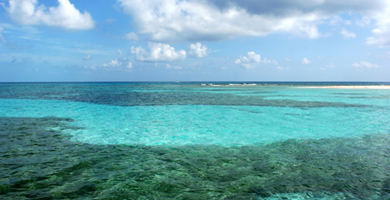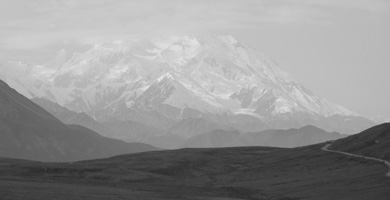From Ruins To Rainforest: The Bounty of BELIZE
An insider’s guide to this magical Central American destination, rich in ancient Mayan culture, exotic wildlife and underwater beauty
For travelers looking for a destination with that rare mix of ancient culture, active adventure, natural beauty and perfect beaches, Belize is the perfect prescription. Unique among Central American nations, Belize is English speaking, compact (about the size of New Jersey), and un-crowded. The laid-back destination offers warm waters teeming with aquatic life, lush jungles and luxurious lodges.
Progressive in its conservation efforts, the new government, after gaining independence in 1981, set aside 40 percent of the territory as protected land. Safeguarding of pristine forest and marine habitats has continued with the establishment of many additional public and private reserves. Known as British Honduras beginning in 1862, this territory had been an outpost for pirates and loggers since the early 17th century. Prior to European settlement, the Maya occupied this land for more than 3,000 years. Over the centuries, they erected dozens of cities around elaborate temples and plazas. Belize’s size—just 180 miles from north to south and 68 miles east to west—allows travelers to mix active adventure with relaxation. Visits to tropical forest and mountain lodges can be conveniently paired with downtime at luxurious island and beach hotels.
The Cayo District: Wildlife and Maya Cities
El Castillo, Xunantunich
Above the town, the hillside Maya site of Cahal Pech contains seven plazas, as well as restored ball courts and temples. Xunantunich, southwest of San Ignacio, is one of the most accessible and well-excavated Maya sites in Belize. Temples flank the site’s central plazas. The largest temple (known as El Castillo) rises 130 feet and allows views of the distant Guatemalan border. It’s also a great place to see stelae, upright stone monuments or tablets with an inscribed or sculptured surface, and several intricate ones unearthed here are now protected from the weather in the site’s museum.
The famous Actun Tunichil Muknal (“ATM”) Cave, seven miles south of Belmopan, can also be reached from San Ignacio. Here, hikers can travel 45 minutes through the forest to reach a narrow cave. A clear stream flows from the entrance, filling many of the chambers with waist high water. Inside, more than a dozen ancient skeletons lie encrusted with calcium, glittering under flashlight.
Just south of San Ignacio, the Mountain Pine Ridge Forest Reserve protects nearly 300-square miles of pine forest, rivers and waterfalls. The reserve, in the foothills of the Maya Mountains, is home to toucans, parrots, and motmots. Members of this bird species, like the Blue-crowned motmot, have distinct tail feathers that twitch like the pendulum of a clock. They can be distinguished by their characteristic red eyes, turquoise crown and black face and call–a double hoot like an owl. The handful of lodges located within the Mountain Pine Ridge offer bird watching tours.
Other excursions include horseback trips to the area’s waterfalls and caves, including turquoise Rio On Pools, the golden Rio Frio Cave, and Thousand Foot Falls (Hidden Valley Falls).
Ambergris Caye – Reef and Relaxation
After exploring the interior, Belize’s Caribbean coast was calling. More than 200 small islands lie within Belizean waters. One of the most welcoming and convenient is Ambergris Caye, a low island ringed by white sand, mangrove habitat and calm waters.
At 25 miles long and less than a mile wide, Ambergris Caye’s (pronounced “am-BURR-gris key”) small size makes travelers feel at home quickly. The island’s only town, San Pedro, fills just three blocks from the seaside to the lagoon. Its sandy boulevards (with names like Chicken Street and Coconut Drive) are best navigated by foot, bicycle, or golf cart. North and south of town, a fine collection of boutique hotels lines the eastern shore, many with fewer than 20 guestrooms. Local restaurant specialties include fresh lobster (from July to February) and conch (from October to June). Coconut and key-lime ice creams are available year-round.
Ambergris Caye’s greatest allure is its aquatic playground; the Belize Barrier Reef lies less than a quarter mile off the eastern shore. World-class snorkeling sites such as Hol Chan, Shark Ray Alley, Mexico Rocks, and Rocky Point can be reached in less than 20 minutes. Divers travel across the globe to experience trips to Turneffe Islands Atoll and Lighthouse Reef Atoll—site of the Great Blue Hole. Windsurfing, sailing, sport fishing, and parasailing add to the endless adventure, along with day trips to the mainland for cave tubing, visiting the coastal manatee habitats; and tours of the Maya cities of Altun Ha, Lamanai, and even Tikal.
Placencia – Diving with Giants
Whale Shark, Gladden Spit
If you’re a serious diver, Placencia should be near the top of your list. The town is located at the end of a long, narrow peninsula that runs parallel to the mainland. Its original name, Punta Placentia, means Pleasant Point—a reference to its calm waters and mild weather. Most people come to enjoy Placencia’s beaches and nearby dive zones. Laughing Bird Caye National Park and South Water Caye Marine Reserve sit eleven miles offshore. The area’s most famous dive site, the Gladden Spit, is a prime whale shark habitat. These curious giants can be observed (usually on night dives) from March to May and between August and October.
Placencia town is tiny and relaxed: a collection of seafood restaurants and handicraft shops bordering a long central sidewalk. Our favorite resorts are located farther up the peninsula, where development thins and coastal vegetation thickens. Here you’ll find long stretches of powdery beach—perfect for swimming, kayaking and sunbathing. Other activities include sailing, sport fishing, and ultralight flights. On one of my first trips to Belize, I remember a post-dive dinner accompanied by traditional dügü drumming, the rhythm of the Garifuna people, descendants of runaway slaves. The cashew wine was flowing, and the hospitality was as warm as the Caribbean breeze.
Farther inland, boat tours ply the Monkey River mangroves. Howler monkeys, crocodiles, and colorful birds are common here, with an occasional appearance by the shy manatees. For more serious wildlife viewing, arrange a privately guided tour to the Cockscomb Basin Wildlife Sanctuary. This mountainous forest area is home to jaguar, tapir, macaws, and toucans. Trips to the Maya sites at Nim Li Punit and Lubaantun are worthy as well.
The Toledo District — Off the Beaten Path
Toledo District, in Belize’s south, has recently emerged as an upscale option to the Cayo District. Visitors can now enjoy luxury accommodations on a private 12,000-acre rainforest preserve that also shelters ocelots, kinkajous, and tapirs. The region is gaining additional attention for its accessible Maya sites, scenic caves and waterfalls, and pristine reefs. Lubaantun, 25 miles northwest of the coastal port of Punta Gorda, is the largest ceremonial center in southern Belize. The settlement’s eleven major structures are clustered around five plazas. Unlike most Maya cities, Lubaantun was constructed without the extensive use of mortar. Accordingly, the high quality masonry here astounds.
The site is also famous for a controversial crystal skull, reportedly found here in 1926. Seventeen-year-old Anna Mitchell Hedges allegedly discovered this “skull of doom” while accompanying her father on an excavation of Lubaantun’s ancient Mayan city, though the story is rife with inconsistencies and the skull’s authenticity questioned.
Five miles northeast of Lubaantun is the Maya ceremonial center known as Nim Li Punit. This site dates to the Classic Period, and was likely occupied between the 5th and 8th centuries. Several stelae have been unearthed here, including one that depicts a local ruler wearing a large headdress. (Nim Li Punit means “big hat” in Kekchi Maya.) Visitors can also tour a small on-site museum. Nearby, Kekchi Maya villages produce organic cacao—the raw ingredient for chocolate.
Most outings to these Maya sites end with a refreshing visit to Blue Creek Cave, also known as Hokeb Ha or “Where Water Enters the Earth.” This limestone river tunnel begins near the village of Santa Cruz and ends five miles away outside the town of Blue Creek. Outfitted with life jackets and headlamps, visitors can hike or swim to underground waterfalls and float beneath shimmering stalactites.
Near the coast, the Rio Grande River and its neighboring mangrove lagoons are home to the endangered manatees and the rare hicatee turtles. Guided river trips also allow you to observe howler monkeys, iguanas, and dozens of bird species. Offshore, divers and snorkelers can explore the Belize Barrier Reef—the second largest barrier reef in the world. One excellent location is the Port of Honduras Marine Reserve on Snake Caye, approximately 40 minutes by boat from Punta Gorda. The reserve is home to sea fans, coral, colorful reef fish, seahorses, rays, eels, and sea turtles.
My travels here covered an incredibly diverse range of experiences, yet with so much left to explore, it confirmed for me what many modern travelers are discovering: the adventures in Belize are truly endless.
Getting There
The best carriers include American, Delta, United, and TACA airlines. Flights to Belize from the USA usually connect in Houston (2.5 hours), Miami (two hours), Dallas (three hours), or San Salvador (60 minutes).
Belize can also be combined with extensions to other parts of the Maya World, such as Guatemala and Honduras.
When to Go:
The best time to visit is from December to May. Rainy season extends from June to November, with hurricane potential from July to mid-November. Temperatures are fairly constant year-round, with highs in the mid-80s and lows in the 70s. March can be windy on the coast.
Favorite Hotels in Each Location:
Cayo / San Ignacio — Chaa Creek
Ambergris — Mata Chica
Placencia — Turtle Inn
Toledo / Southern Belize — Belcampo Lodge
Story by John Montgomery, with photos by Dreamstime.
John Montgomery is the founder of Mosaico Travel Services, which delivers the finest in custom travel to Central America and South America. Their local expertise and first-hand knowledge ensure that each itinerary will match the traveler’s unique wishes and requirements. From Belize to Patagonia, its network of contacts is at your service. Browse the destinations and start dreaming.
Latest posts by John Montgomery
- From Ruins To Rainforest: The Bounty of BELIZE - March 28, 2013
- Dreaming of PERU - November 27, 2012












